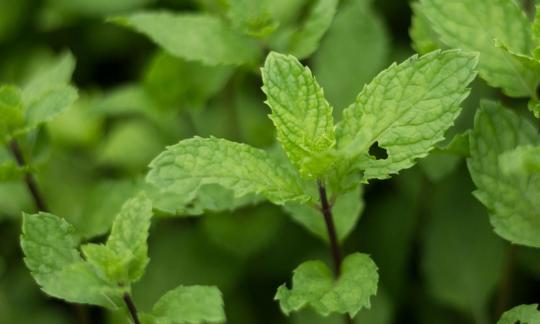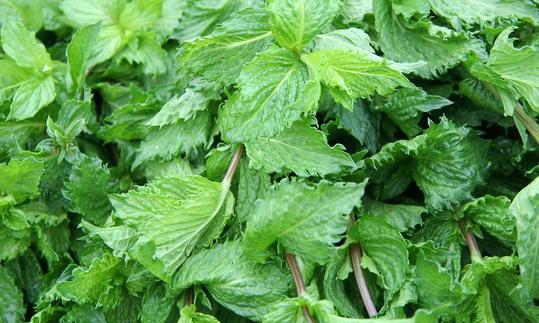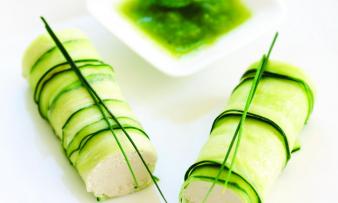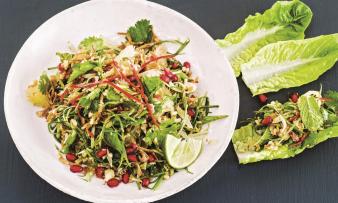Table of contents
Fresh green mint ( Mentha spicata) is used raw to make tea, to season sauces and to garnish dishes. When it comes to herbs, always choose organic ones.
Use in the kitchen
Green mint, also called spearmint, has a slightly sharp and very refreshing taste. Its leaves are light green (young leaves) to dark green and ribbed, without a petiole. There are many other types, subspecies and varieties of mint: A well-known hybrid type is peppermint, and Moroccan mint is a variety of green mint.
Can you eat green mint raw? Fresh mint leaves can be eaten raw. They are versatile and go well in raw food, cooked, savoury and sweet dishes.
Green mint is important in traditional Greek, Turkish and Arabic cuisine (especially for seasoning, garnishing and as an ingredient in teas). It is used in the filling of Greek dolmadakia gialantzi (vine leaves stuffed with wholegrain rice), in vegan melitzanopita ( aubergine pie) or moussaka, as a topping for mujadarra (vegan Arabic dish with lentils and longgrain rice) or as an ingredient in a vegan mint yoghurt dip that goes well with falafel. Green mint has also become an indispensable part of English cuisine; the herb is very popular in combination with peas, e.g. in the mushy peas sauce, or with potatoes.
Green mint can also be found in various salads such as couscous or bulgur salad (Tabbouleh or Kısır). A mint pesto with walnuts or almonds is a good alternative to basil pesto and an ideal way to use up excess raw mint. Frozen in ice cubes, mint leaves give any shake, drink or water a fresh kick. They are often combined in desserts with fresh fruit such as watermelon, strawberries, limes,blueberries, blackberries, grapefruit, pomegranates or with dark chocolate.
Fresh spearmint is also popular as an ingredient in hot and cold drinks, whether in a healthy smoothie, non-alcoholic mojito, mint syrup drink or as fresh mint tea.
Vegan recipe for smoothie with green mint
Ingredients (for 4 glasses of 250 ml each): 100 g spinach, 20 g kale (1 handful), 1 apple, 20 g raw ginger, 4 stalks of green mint (raw, organic), 2 tbsp lime juice, 2 tbsp oat flakes, 400 ml water.
Preparation: Wash the spinach and kale and shake dry. Wash the apple, core it and cut it into pieces. Peel the ginger and also cut it into pieces. Wash the organic mint, shake it dry and separate the leaves from the stem. Put all the ingredients together with the water in a blender and puree finely. Then pour the finished, raw vegan smoothie into four glasses and enjoy.
Tea preparation
To prepare a tea from fresh, organic green mint, put three to four well-rinsed stems and leaves in a large glass and pour hot, but no longer boiling, water over them. Allow the tea to steep for a while and remove the mint before drinking. Sweeten with agave syrup if necessary. The tea is very digestible and is suitable for daily consumption as well as for gastrointestinal complaints.
Vegan recipes with raw spearmint can be found under the note: " Recipes that have the most of this ingredient ".
| Not only vegans or vegetarians should read this: Vegans often eat unhealthily. Avoidable nutritional errors. |
Purchasing - Storage
Fresh mint is available all year round (mostly cut) from major retailers such as Coop, Migros, Denner, Volg, Spar, Aldi, Lidl, Rewe, Edeka, Hofer and Billa. It is organic in organic supermarkets such as Denn's Biomarkt and Alnatura. You will often find non-specific names such as ' peppermint ' or 'mint' in stores. The labelling of the plant species is therefore not always clear. You have a good chance of finding green mint online or in garden centres (Bauhaus), which sell the herb either as a pot plant or as seeds for growing at home.
The availability of fresh green mint varies depending on the size of the store, catchment area, etc. Our recorded food prices for the DA-CH countries can be found above under the ingredient image - and by clicking on them you can see their development at various suppliers.
Found in the wild
Green mint is a perennial plant that grows mainly in temperate latitudes. Today, in addition to Europe, the Middle East and China, it is also widespread in North America, parts of South America (Argentina, southern Brazil) and North Africa. 1
There is a general possibility of confusion with all types of mint, as natural hybrids often arise from crossing two species. 2 Horse mint ( Mentha longifolia) is the most similar. Although it is non-toxic, many people find its taste unpleasant and the smell is reminiscent of petroleum. 3,4 Field mint ( Mentha arvensis) also grows wild and is widespread, and is found in Euro-Siberian (= from Europe to Siberia) and North American areas in fields, rubble heaps and damp forest paths. 5
Storage tips
How do you keep mint fresh? If you want to keep green mint fresh, you should put it in a glass of water in the fridge. To keep it fresh for about two days, wrap the stems in damp kitchen paper. If you freeze the mint leaves, they will last even longer and retain their aroma better than dried leaves.
Ingredients - Nutritional Values - Calories
What is the nutritional value of green mint? 100 g of fresh green mint (raw) has a calorie content of 44 kcal. There is hardly any fat, carbohydrates make up about 8.4 g and protein 3.3 g. The fiber content is 6.8 g/100g. 6
Green mint is rich in iron with 12 mg/100g; that makes up 85% of the daily requirement. Fresh marjoram and morels contain a similar amount. Dried herbs contain significantly more iron, but you consume much less: for example, bay leaves have 43 mg of iron per 100g. 6
100 g of green mint contains 1.1 mg of manganese (56% of the daily requirement). Fresh basil has the same amount and fresh dill (1.3 mg/100g) has a similar amount. Sage contains 4 mg/100g, almost four times as much manganese. 6
The folate (folic acid) content in raw spearmint is 105 µg/100g (53% of the daily requirement). This is similar to that of fresh rosemary (109 µg/100g) and fresh peppermint (114 µg/100g). Significantly more folate can be found in raw Mexican goosefoot or in dried herbs (eg in coriander leaves : 274 µg/100g). 6
The complete ingredients of raw green mint, the coverage of the daily requirement and comparison values with other ingredients can be found in our nutrient tables. In the article Nutrients explained you will get a detailed insight into the topic.
Effects on health
Is green mint healthy? Raw green mint has more than 35 different ingredients and contains, in addition to vitamins, numerous secondary plant substances (including various essential oils) that are important for human health. 3,7
Secondary plant substances
Many of the health effects of green mint can be attributed to the secondary plant substances it contains. Our article on secondary plant substances provides an overview of the classification of the substance groups, their occurrence in foods and possible effects on humans.
Green mint contains the following secondary plant substances:
- Isoprenoids : monoterpenes and terpenoids (carvone, limonene, linalool, piperitone, piperitone oxide, menthol, menthone, isomenthone, pulegone, alpha-pinene, beta-pinene, eucalyptol, carvacrol, carveol, camphene, p-cymene), triterpenes (steroids), sesquiterpenes (caryophyllene, germacrene 2.9, 10.23
- Alkaloids 23
- Polyphenols : Phenolic acids: hydroxybenzoic acids (syringic acid, gallic acid, vanillic acid, salicylic acid), hydroxycinnamic acids (cinnamic acid, ferulic acid, sinapic acid, rosmarinic acid, caffeic acid, salvianolic acid, p-coumaric acid, chlorogenic acid, caffeoylquinic acid); flavonoids: flavones (luteolin, apigenin), flavanones (naringenin, hesperidin, eriocitrin), flavonols (kaempferol, rutin, quercetin, isorhamnetin); tannins 7,11,21,22,23
- Other organic compounds: glycosides, Coumarins 23
However, it should be noted that the composition of the secondary plant substances in spearmint can vary depending on the variety, time of harvest and growing conditions. Therefore, quantities are only of limited use and should only be understood roughly.
Essential oils can be extracted from all types of mint using steam distillation. These contain various terpenes and terpenoids, such as limonene, carvone, pulegone or menthone (and menthol) as the main component. 2 The essential oils and extracts of green mint have various health properties. Among other things, they have antipyretic, antiparasitic, anti-inflammatory, antimicrobial, antidiabetic, antioxidant, diuretic and anti-cancer effects. The antibacterial effect is mainly attributed to the high concentrations of carvone, e.g. in spearmint. 10 Carvone also acts as a fungicide and insect repellent. 9 Researchers have also found positive effects on cognitive performance in both younger and older groups of people when taking mint extracts. 11
Scientists attribute the antibacterial and antifungal effects of mint to the bioactive substances it contains, such as terpenes, steroids, alkaloids, flavonoids, tannins and coumarins. 23
The numerous polyphenols in mint can prevent the development of various human diseases such as cardiovascular diseases, atherosclerosis, cancer, diabetes, cataracts, cognitive dysfunction and neurological diseases. 21
Further research is needed to better scientifically prove the medicinal properties of spearmint and its use for human health.
Dangers - Intolerances - Side effects
Caution is generally advised when dealing with essential oils. Here too, the dose makes the poison. As the German Federal Institute for Risk Assessment states, large amounts of essential oils (including menthol) can have harmful effects on the central nervous system, kidneys and respiratory tract, especially in small children. 12 When using menthol in babies and small children, there is a risk of glottic spasm (glottic spasm, laryngospasm), which can lead to respiratory arrest. As a precaution, mint oil is not recommended for children under 4 years of age. 18
Use as a recognized medicinal plant
Raw spearmint has long been used to treat various ailments. Among other things, spearmint has a traditional use against diabetes, stomach upset, headaches and fatigue, asthma, bronchitis, chest pain and lung diseases, laryngitis, skin problems, colds and flu symptoms. 10
Commission E has approved mint oil in general for the following medical uses: internally for bloating, stomach, intestinal and gallbladder complaints and catarrh. Externally for muscle pain, nerve pain and as a nasal ointment. 18
Folk medicine - natural medicine
In folk medicine, green mint is used as a herbal medicine to treat colds, respiratory diseases, respiratory problems, hemorrhoids and stomach pain. When prepared as a tea, the mint leaves are said to have a carminative (flatulent) property that can be used against indigestion, fever, nausea, vomiting and gastrointestinal problems. 9
Ecological footprint - animal welfare
The CO 2 footprint of a food depends on various factors. The type of agricultural production (conventional vs. organic), average or seasonal or regional production, domestic production or import by truck, ship or plane, different types of packaging and whether the goods are fresh or frozen play a decisive role. 13 Despite extensive research, however, we were unable to find any precise figures on the ecological footprint of spearmint.
Organically grown spearmint is preferable to conventionally grown mint because organic farming avoids the use of synthetic fertilizers and pesticides. Interestingly, the essential oils of mint itself have shown promising effects as a bioherbicide. For example, the use of mint oils stopped the growth and ultimately killed weeds in a 2019 study. 20 Since the synthetic herbicides and pesticides used in conventional agriculture have a negative impact on the environment, this could offer a promising alternative.
If you use mint to make tea, make sure you only boil the amount of water you really need. One tea manufacturer explained that 36% of its total carbon footprint created in 2021 was due to boiling the tea water, as consumers sometimes boiled twice as much water as necessary. 19
For detailed explanations of various sustainability indicators (such as ecological footprint, CO2 footprint, water footprint), see our article: What does the ecological footprint mean?
Worldwide occurrence - cultivation
The original distribution area of spearmint extends from Europe through the Middle East, the Caucasus region, Turkmenistan, Pakistan and Nepal to China. 3 Today it is cultivated worldwide. The largest producers of spearmint and peppermint in 2021 were Morocco, Argentina, Mexico and Japan. 14
Cultivation - Harvest
Green mint grows best in temperate climates and in partially shaded to sunny locations. If there is too much shade, less aroma develops. 1.15 The flowering period is from July to September. 3
Green mint is very easy to grow yourself by sowing. To do this, fill the seeds in a seed tray with peat sand or poor seed compost in March, moisten with water from a spray bottle and sow the seeds mixed with bird sand. Press the seeds down lightly, put a plastic bag over the seed tray and place it in a partially shaded window spot. At temperatures around 20 °C, the seeds germinate within two weeks. 16 The mint cuttings are planted from mid-May, when they are 15 to 20 cm long, either in the bed or in a pot. They thrive best in a partially shaded, sheltered location with nutritious, humus-rich and well-drained soil. 16
Since all mints have invasive characteristics, you should use a rhizome barrier when planting in the garden. This prevents the root runners from spreading throughout the garden. Alternatively, you can plant each cutting in a large pot without a bottom. 16
Further information
Green mint ( Mentha spicata) belongs to the genus of mints ( Mentha), which is subordinate to the mint family (Lamiaceae). 11 A well-known variety of green mint is Moroccan mint ( Mentha spicata var. crispa), which is sometimes also called Nana mint. These curly-leaved Mentha varieties (sometimes called Mentha crispa) include: M. aquatica var. crispa and M. longifolia var. crispa. Such varieties are said to have a typical curly mint-like smell. 17
InfoFlora lists (according to Flora Helvetica) the following known species for Switzerland: Mentha spicata L. (green mint), Mentha x verticillata (whorled mint), Mentha pulegium (penguin mint), Mentha longifolia (horse mint), Mentha aquatica (water mint), Mentha arvensis L. (field mint), Mentha × piperita L. (peppermint) and Mentha suaveolens Ehrh. (Round-leaved mint). There are around 25-30 recognized species worldwide, and there are many more of this genus.
Although peppermint ( Mentha x piperita L.) and spearmint are often used as synonyms, peppermint is a hybrid of spearmint, created by crossing it with water mint ( Mentha aquatica). Compared to peppermint, spearmint has a milder taste because it has a lower menthol content. 2
Be careful with "Argentine mint"! As the Latin name suggests, it is not mint ( Aloysia polystachya or Lippia p.); the plant belongs to the verbena family and is also known as mint verbena.
Alternative names
Green mint is also known as spearmint, curly mint, spearmint or spearmint. 3 The Latin name Mentha viridis is considered a synonym. 2
Other uses
In addition to its use as a culinary herb, extracts of the plant are used in cosmetic products, soaps, chewing gum, toothpaste, mouthwash or antiseptic mouth rinses. 9
Bibliography - 21 Sources
| 1. | Royal botanic garden Kew. Plants of the world online. Mentha Spicata L. |
| 2. | Reiner H. Vielseitig nutzbar: Minzen. Garten. 1996;119(3):24-26. |
| 3. | Pflanzen-Vielfalt net: Grüne Minze – Bestimmen/Erkennen, sammeln und verwenden. |
| 4. | Pflanzen-Vielfalt net: Rossminze – Bestimmen/Erkennen, sammeln und verwenden. |
| 5. | Infoflora: Mentha arvensis L. Acker-Minze. 2023. |
| 6. | USDA United States Department of Agriculture. |
| 7. | Mahendran G, Verma SK, Rahman LU. The traditional uses, phytochemistry and pharmacology of spearmint (Mentha spicata L.): A review. J Ethnopharmacol. 2021;278:114-266. |
| 9. | Ay Kee L, Bakr Shori A, Salihin Baba A. Bioactivity and health effects of Mentha spicata. Integr Food Nutr Metab. 2017;5(1):1-2. |
| 10. | El Menyiy N, Mrabti HN et al. Medicinal uses, phytochemistry, pharmacology, and toxicology of Mentha spicata. Ramachandran S, Herausgeber. Evidence-Based Complementary and Alternative Medicine. 2022;2022:1–32. |
| 11. | Falcone PH, Nieman KM et al. The attention-enhancing effects of spearmint extract supplementation in healthy men and women: a randomized, double-blind, placebo-controlled, parallel trial. Nutrition Research. 2019;64:24–38. |
| 12. | BfR Bundesinstitut für Risikobewertung. Die Dosis macht das Gift - auch pflanzliche Duftstoffe sind nicht immer harmlos. 07/2002. |
| 13. | Reinhardt G, Gärtner S, Wagner T. Ökologische Fussabdrücke von Lebensmitteln und Gerichten in Deutschland. Institut für Energie- und Umweltforschung Heidelberg ifeu. 2020;1-22. |
| 14. | FAO org: Crops and livestock products. Production Quantity. Peppermint / Spearmint. 2021. |
| 16. | Gartenjournal de: Minze züchten leicht gemacht: Schritt für Schritt Anleitung. |
| 17. | Arzneipflanzenlexikon info: Krauseminze. |
| 18. | Arnzeipflanzenlexikon info Minze. |
| 19. | Pukkaherbs com: PUKKA. Our 2021 Impact Report. [online, aufgerufen am 01.09.2023 über Google Drive]. |
| 20. | Sarheed MM. Allelopathic compounds from Mint target the cytoskeleton from cell biology towards application as bioherbicides. 2019. |
| 21. | Ćavar Zeljković S, Šišková J et al. Phenolic Compounds and Biological Activity of Selected Mentha Species. Plants. 2021;10(3):550. |
| 22. | Bhagwat S, Haytowitz DB, Holden JM. USDA Database for the Flavonoid Content of Selected Foods, Release 3. Beltsville: Nutrient Data Laboratory, Beltsville Human Nutrition Research Center, Agricultural Research Service, U.S. Department of Agriculture; September 2011;1-107. |
| 23. | Ullah N, Khurram M et al. Comparison of Phytochemical Constituents and Antimicrobial Activities of Mentha spicata from Four Northern Districts of Khyber Pakhtunkhwa. J Appl Pharm Sci. 2011;1(7):72-76. |













Comments